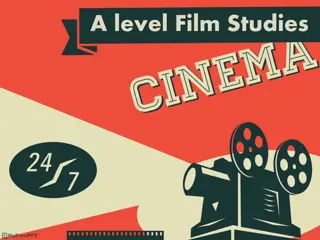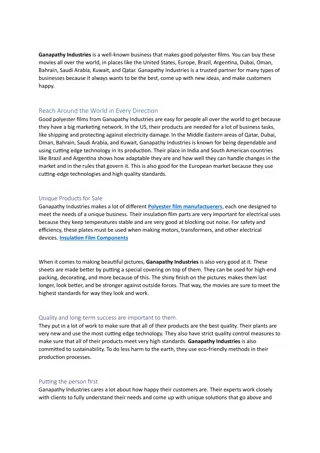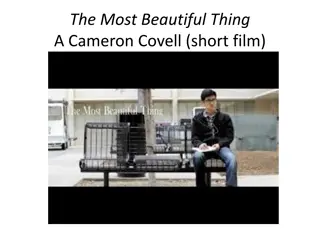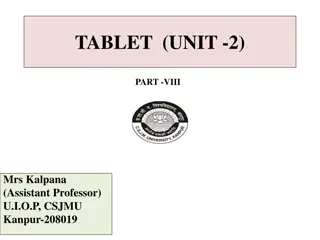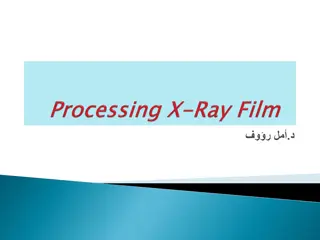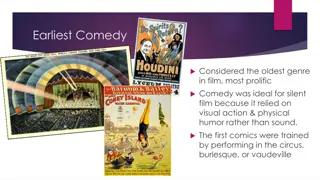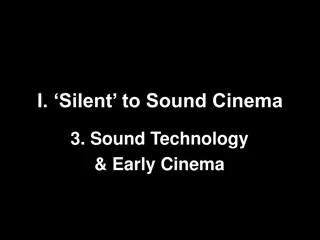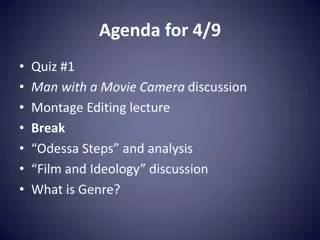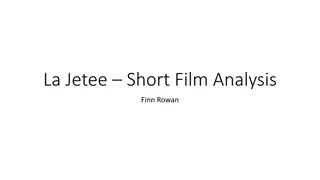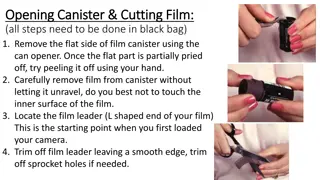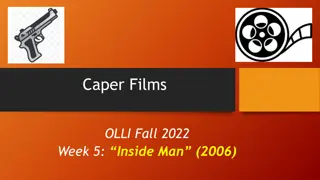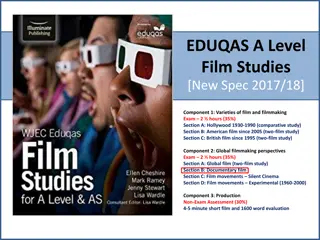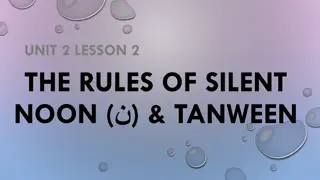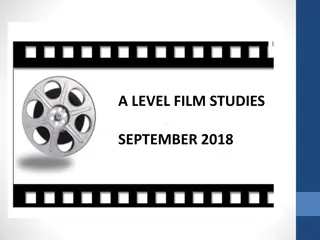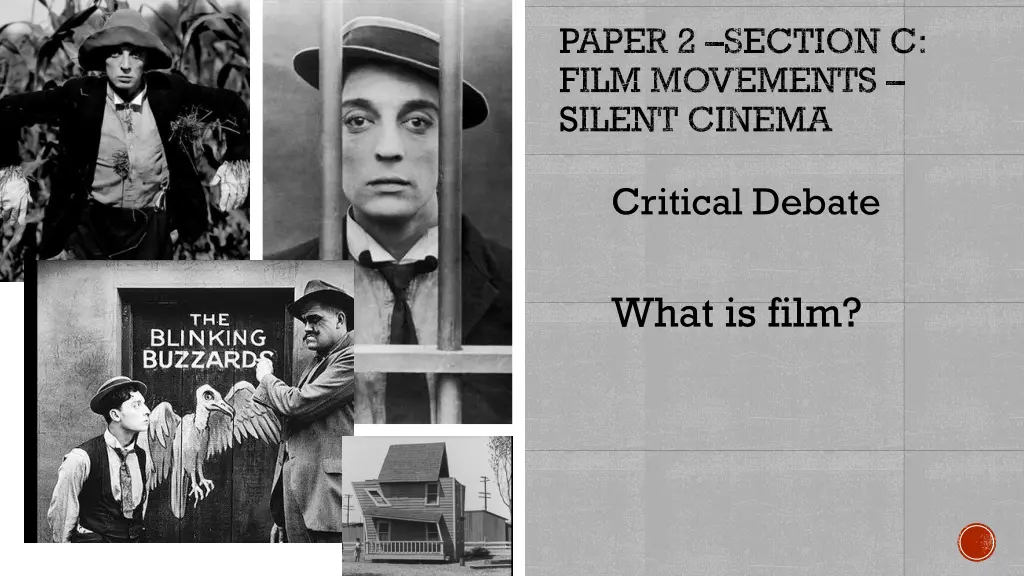
Exploring Film Realism vs. Expression: Critical Debate in Silent Cinema
Delve into the critical debate surrounding film as a realist or expressive medium in Silent Cinema. Should filmmakers portray reality as is or transform it creatively? Understand the historical context from Lumière Brothers to Georges Méliès, and the impact of theorists like André Bazin on cinematic philosophy. Dive into the nuances of realism and expressionism in filmmaking during the formative years of cinema.
Download Presentation

Please find below an Image/Link to download the presentation.
The content on the website is provided AS IS for your information and personal use only. It may not be sold, licensed, or shared on other websites without obtaining consent from the author. If you encounter any issues during the download, it is possible that the publisher has removed the file from their server.
You are allowed to download the files provided on this website for personal or commercial use, subject to the condition that they are used lawfully. All files are the property of their respective owners.
The content on the website is provided AS IS for your information and personal use only. It may not be sold, licensed, or shared on other websites without obtaining consent from the author.
E N D
Presentation Transcript
PAPER 2 SECTION C: FILM MOVEMENTS SILENT CINEMA Critical Debate What is film?
This debate centres on whether film should be a realist or an expressive medium. In other words, should a filmmaker be concerned with representing the world as is, for example in the manner of a documentary, or should a filmmaker regard the medium as a creative one in which the everyday world is transformed?
The Lumires Brothers conceived of this new invention as one for recording found reality and in so doing encouraging the spectator to gaze freshly on a world that might otherwise be taken for granted. By contrast George M li s made fantasy films of great imagination and creativity. https://www.youtube.com/watch?v=L8is28gAOTc https://www.youtube.com/watch?v=CEQQefvfnk4 https://www.youtube.com/watch?v=1dgLEDdFddk
CRITICAL DEBATES THE REALIST AND THE EXPRESSIVE For this section of the exam you will need to be familiar with what is referred to by Eduqas as a critical debate in this instance the realist and the expressive . This is what they say about it in the specification: Learners are required to study the following debate.. in relation to [silent cinema]: The realist and the expressive. In the 1940s, the French film critic Andre Bazin set in motion a major debate when he argued that both German Expressionist and Soviet Montage filmmaking went against what he saw as the realist calling of cinema. This opposition between the realist and the expressive has informed thinking about film from the beginnings of cinema when the documentary realism of the Lumie re Brothers was set in opposition to the fantasy films of Me lie s. In the period between 1895 and 1930 the conventions of film as we know them were in the process of being established and were very much up for grabs. As we have seen, the silent era was a period of great innovation and creativity as filmmakers experimented with new ways of making meaning and explored the new creative possibilities that the medium of film had opened up. Some filmmakers of this period explored the use of techniques that would create a sense of realism and encourage the suspension of the audience s sense of disbelief, others explored more abstract or expressive techniques, others still combined elements of realism with a more expressive approach. There is an excellent document published by the exam board which explores the issue of realist and expressive approaches in silent film, it is something you MUST read http://resource.download.wjec.co.uk.s3.amazonaws.com/vtc/2017-18/17-18_3-10/silent-film.pdf. When watching our set film for this unit you will need to keep this debate in mind and consider the extent to which the film can be considered realist and the extent it can be considered expressive.
CRITICAL DEBATES THE REALIST AND THE EXPRESSIVE ANDR BAZIN The specification and the guidance notes on the realist and expressive debate in relation to silent film mention the French film critic and theorist Andr Bazin. Bazin was active in the 1940s and 1950s and set up the hugely influential magazine Cahiers du Cinema which inspired the French New Wave film movement of the 1950s and 60s indeed many New Wave filmmakers were regular contributors to the magazine. In a series of essays written in the 1940s and 1950s Bazin wrote in praise of realist cinema arguing that it gave the audience the space to interpret a film for themselves. He was critical of the expressive approach taken by the German Expressionist and Soviet Montage movements as he felt their stylistic exaggeration directed audiences towards pre determined readings. Many of Bazin s ideas are summarised in an essay written in the early 1950s, The Evolution of the Language of Cinema, published in the compilation of his major essays What is Cinema? (page 23):https://qmplus.qmul.ac.uk/pluginfile.php/640193/mod_resource/content/2/bazi n-andre-what-is-cinema-volume-1-kg.pdf. As we watch our set films you will need to have an awareness of Bazin s arguments and be able to apply them to Keaton s films. The sources on the next few slides summarise Bazin s ideas well.
ANDRE BAZIN https://www.youtube.com/watch?v=j_MUi-rBFis
the French critic Andr Bazin opposed to artificial films, supporting Italian Neo- Realism, he declared that this film movement represents the true calling of cinema which is to enable us to look intently and deeply into the ordinary world around us, represented by the filmmaker in an unadorned documentary style. He rejected the flamboyantly expressive Soviet and German cinemas of the 1920s, seeing their visuals as a betrayal of this true calling of cinema. Bazin s writing is the first significant critique of the major silent cinema movements of the 1920s so we need to take it seriously if only for that reason. Much film and media studies theory is based on assumptions that, of course, film is highly mediated, constructed, manipulative, etc. More recently these qualities of film have been explored less in negative terms and more in terms of how they are central to what audiences find pleasurable and what attracts creative people to want to use the film mediumto precisely express themselves.
Bazins intervention can be seen as a very useful way of calling time out on our assumptions about what a film is and what it should be. There is surely a place for the kind of slow cinema that enables us to reflect on the world, to be more attentive to the ordinary. Bazin was bothered by the capacity of film for propagandist purposes, especially with Soviet cinema, and more broadly with the manipulation of audience emotions which is the case with both Soviet and German films of the 1920s.
ANDR BAZIN USEFUL SOURCES AND SUMMARIES OF HIS IDEAS ON REALISM It s a quote from a Wikipedia entry but it s a good simple summary of Bazin s ideas on realism: [Bazin] is notable for arguing that realism is the most important function of cinema. His call for objective reality, deep focus, and lack of montage are linked to his belief that the interpretation of a film or scene should be left to the spectator. This placed him in opposition to film theory of the 1920s and 1930s, which emphasized how the cinema could manipulate reality. https://en.wikipedia.org/wiki/Andr _Bazin Writing in a 1999 Sight and Sound article Peter Matthews also sums up Bazin s arguments, especially his objection to more expressive film movements, well: [Bazin] took a notoriously dim view of Robert Wiene s The Cabinet of Dr. Caligari (1919) and other films made in the German expressionist style because he judged their elaborate manipulations of lighting and decor a wilful attempt to bend reality out of shape and force it to reflect perverse states of mind. What Bazin objected to in the work of Sergei Eisenstein was how the Soviet director splintered reality into a series of isolated shots, which he then reassembled through the art of montage. Bazin distrusted montage on the grounds that its dynamic juxtaposition of images hurtles the viewer along a predetermined path of attention, the aim being to construct a synthetic reality in support of a propagandist message. https://www.bfi.org.uk/news-opinion/sight-sound-magazine/features/andre-bazin-divining-real-film- criticism-overview
ANDR BAZIN USEFUL SOURCES AND SUMMARIES OF HIS IDEAS ON REALISM Bazin s arguments are also summarised well in a 2013 article in BFI s Sight and Sound magazine by Pasquale Iannone: One of the famous theoretical debates of the 1940s set up a clear dichotomy between (Soviet) montage cinema and filmic realism. Coming down firmly on the side of realism, French critic and theorist Andr Bazin argued that montage cinema was didactic and manipulated the viewer into a particular point of view. On the other hand, realism and its stylistic devices such as deep focus and long takes helped the filmmaker maintain an aesthetic of reality without imprisoning the viewer which Bazin argued was the case in montage cinema. https://www.bfi.org.uk/news-opinion/sight-sound-magazine/features/deep- focus/roots-neorealism In his notes on silent cinema published by Eduqas, Patrick Phillips explores Bazin s argument further: This debate centres on whether film should be a realist or an expressive medium. In other words, should a filmmaker be concerned with representing the world as is, for example in the manner of a documentary, or should a filmmaker regard the medium as a creative one in which the everyday world is transformed? In film history this divide is traced all the way back to the period around 1895-1902 in France. The Lumi re Brothers conceived of this new invention as one for recording found reality and in so doing encouraging the spectator to gaze freshly on a world that might otherwise be taken for granted. By contrast George M li s made fantasy films of great imagination and creativity. A moral dimension to this opposition was introduced in the 1940s by the French critic Andr Bazin. In supporting Italian Neo-Realism, he declared that this film movement represents the true calling of cinema which is to enable us to look intently and deeply into the ordinary world around us, represented by the filmmaker in an unadorned documentary style. By contrast he denounced the flamboyantly expressive Soviet and German cinemas of the 1920s, seeing their high-blown visual rhetoric as a betrayal of this true calling of cinema. While it may be easy to take-on Bazin s argument, his writing is the first significant critique of the major silent cinema movements of the 1920s so we need to take it seriously if only for that reason. http://resource.download.wjec.co.uk.s3.amazonaws.com/vtc/2017-18/17- 18_3-10/silent-film.pdf
THIS TOPIC WILL COME DOWN TO A QUESTION (FROM A CHOICE OF TWO) WHICH MUST BE ANSWERED IN APPROXIMATELY 30 MINUTES. E.G. (a) Discuss how far your chosen film or films reflect aesthetic qualities associated with a particular film movement. Or (b) Discuss how far your chosen film or films reflect cultural contexts associated with a particular film movement.



